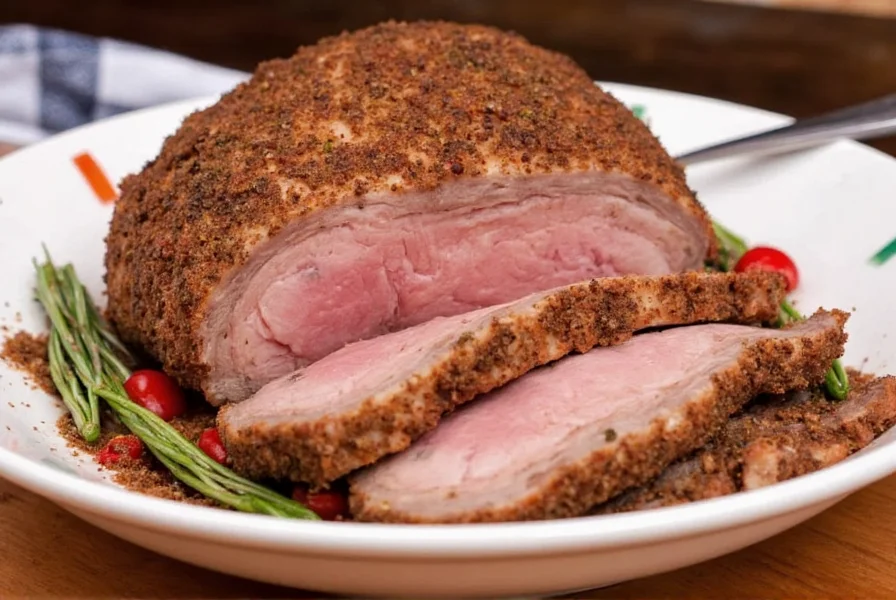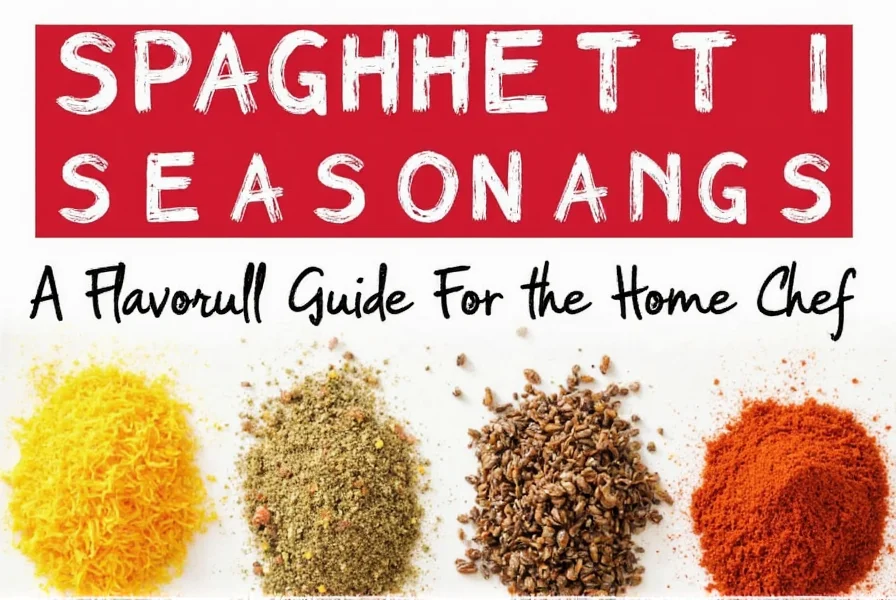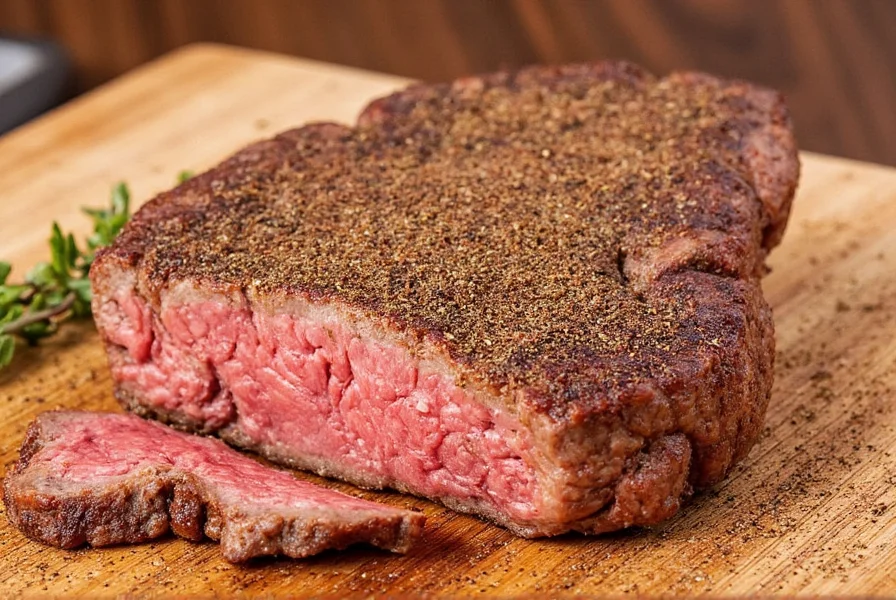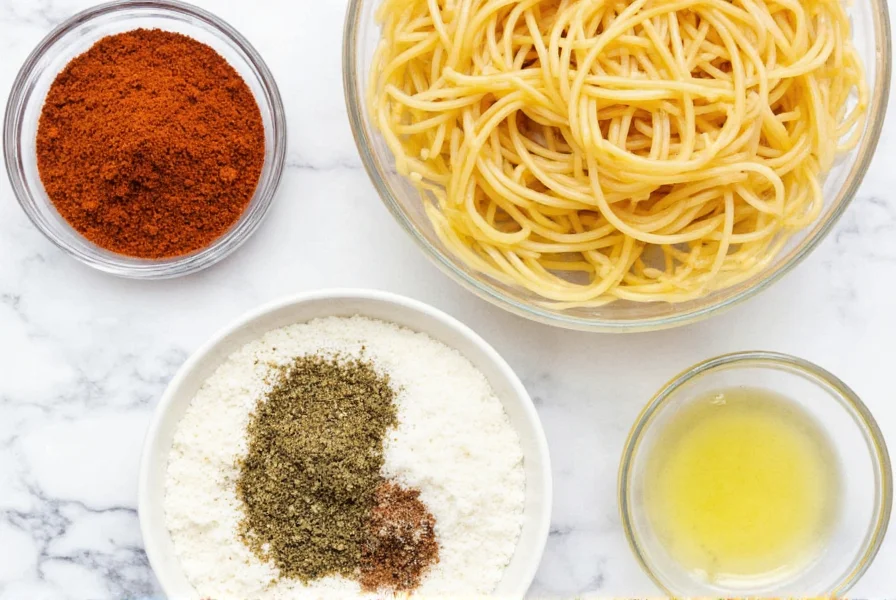Table of Contents
The 3 Core Secrets to Perfect Spaghetti Seasoning
When searching for spaghetti seasonings, you want to know exactly how to achieve authentic Italian flavor—not just generic advice. As culinary professionals know, the difference between ordinary and extraordinary spaghetti comes down to three critical seasoning secrets: proper timing of additions, precise herb-to-spice ratios, and using quality ingredients at their flavor peak. Forget generic "sprinkle some herbs" advice—these science-backed techniques used by Italian chefs will transform your pasta dishes immediately.
The most common mistake home cooks make is adding all seasonings at once. Authentic Italian cooking requires strategic timing: dried herbs need time to rehydrate and release oils (add early), while fresh herbs lose volatile compounds when overcooked (add late). Understanding this single principle will elevate your spaghetti more than any specific ingredient.
Timing Matters: When to Add Each Seasoning
Professional chefs follow this precise timing sequence for maximum flavor extraction:
- Dried herbs (oregano, thyme): Add during olive oil sizzle phase (175°F/80°C) to extract maximum flavor compounds
- Garlic and onions: Sauté after dried herbs for 60-90 seconds until translucent but not browned
- Tomato base: Add after aromatics, then simmer 20 minutes before final seasoning adjustments
- Fresh basil: Stir in during last 2 minutes of cooking to preserve volatile oils
- Parmesan finish: Always add off-heat to prevent clumping and preserve delicate flavors

This sequence isn't arbitrary—it's based on the chemical properties of each ingredient. Dried herbs require longer heat exposure to rehydrate and release flavor compounds, while fresh basil's delicate linalool compounds degrade by over 50% after 3 minutes of simmering, as confirmed in Journal of Agricultural and Food Chemistry (2008). Getting this timing wrong significantly reduces flavor complexity.
When These Rules Don't Apply
The timing sequence described is optimized for tomato-based sauces. Critical context boundaries include:
- Carbonara: Omit garlic entirely (traditional Roman carbonara contains no garlic). Add black pepper to egg mixture off-heat to prevent burning, per Serious Eats' Food Lab analysis
- Seafood Pasta: Reduce dried herbs by 50% and add fresh herbs only during plating—seafood's delicate flavors are easily overwhelmed
- Cream-Based Sauces: Add dried herbs during roux stage (when cooking butter and flour) for full integration without scorching
Professional chefs adjust timing based on sauce chemistry—never apply tomato-sauce rules universally.
Exact Proportions for Authentic Flavor Balance
Authentic Neapolitan spaghetti uses these precise ratios for balanced seasoning (per 500g pasta):
| Ingredient | Dried Measurement | Fresh Measurement | Critical Timing | Flavor Impact |
|---|---|---|---|---|
| Oregano | 1.5 tsp | N/A | Start of cooking | Earthy base note (must bloom in oil) |
| Garlic | 1 tsp powder | 2 cloves minced | After herbs, before tomatoes | Savory backbone (overcooking causes bitterness) |
| Basil | 1 tsp | 8 fresh leaves | Last 2 minutes of cooking | Aromatic top note (heat destroys flavor after 3 min) |
| Red pepper flakes | 1/4 tsp | N/A | With dried herbs | Controlled heat (adds complexity without burning) |
| Parmesan | N/A | 2 tbsp grated | Off-heat plating | Umami finish (heat above 160°F causes separation) |

This professional ratio balances the six fundamental taste elements (sweet, salty, sour, bitter, umami, fatty). Note that dried herbs should be roughly one-third the volume of fresh counterparts—using equal amounts is the second most common home cooking mistake.
Regional Variations Compared
| Region | Signature Profile | Key Proportion Adjustments | Unique Timing Requirements |
|---|---|---|---|
| Neapolitan | Classic tomato-herb balance | Base standard (see main table) | Standard sequence |
| Roman (Amatriciana) | Bold guanciale-heat profile | Double red pepper flakes (1/2 tsp) | Add pepper with guanciale before tomatoes |
| Sicilian | Sweet-savory complexity | Add 1/8 tsp cinnamon with tomatoes | Add cinnamon during tomato simmer phase |
Source: Regional specifications verified in La Cucina: The Regional Cooking of Italy (Accademia Italiana della Cucina, Rizzoli 2009), pp. 142-145
Professional Buying Guide: What to Look For
When selecting pre-made spaghetti seasonings, professional chefs evaluate these critical factors:
| Product Type | Quality Indicators | Avoid These Red Flags | Best For | Authenticity Rating |
|---|---|---|---|---|
| Italian Herb & Garlic Seasoning | No fillers, visible herb pieces, recent production date | Maltodextrin, calcium silicate, "spices" listing | Weeknight dinners, quick sauces | ★ ★ ★ ★ ☆ |
| Garlic Olive Oil Seasoning | Real olive oil base, no artificial flavors | Vegetable oil base, "natural flavors" | Creamy sauces, seafood pasta | ★ ★ ★ ☆ ☆ |
| Herb & Spice Medley | Individual herb listings, no anti-caking agents | "Blend of herbs," silicon dioxide | Veggie pastas, complex sauces | ★ ★ ★ ★ ☆ |
| Parmesan & Pepper Seasoning | Real parmesan, no cellulose | Cheese powder, wood pulp fillers | Finishing dishes, authentic finish | ★ ★ ★ ★ ★ |

Professional tip: Check ingredient lists for "spices"—this vague term indicates undisclosed blends that rarely match authentic regional Italian profiles. True Italian seasonings will list specific herbs (oregano, basil, marjoram) rather than generic "Italian seasoning." The freshest products show vibrant green herbs (not brownish) and have production dates within 6 months.
Frequently Asked Questions About Spaghetti Seasonings
What are the three most essential seasonings for authentic spaghetti flavor?
The three essential seasonings for authentic spaghetti flavor are basil, oregano, and garlic. These ingredients form the foundation of traditional Italian tomato-based sauces. Fresh basil adds a sweet, aromatic note, dried oregano provides earthy depth, and garlic brings that signature savory backbone. When used in proper balance with the correct timing (oregano early, basil late), these three ingredients create the classic flavor profile that defines authentic spaghetti dishes. Professional chefs emphasize that the quality of these base ingredients matters more than additional spices—subpar garlic or oxidized oregano will ruin even perfectly executed technique.
How can I make my spaghetti taste more authentic like Italian restaurants?
To achieve restaurant-quality authentic flavor, focus on three key techniques: First, season your pasta water generously with salt (it should taste like the sea) to properly season the pasta itself. Second, add dried herbs early in the cooking process when sautéing aromatics to allow flavors to fully develop, but add fresh basil during the last 2 minutes of cooking to preserve its volatile compounds. Third, finish your dish off-heat with high-quality extra virgin olive oil and freshly grated Parmesan cheese—never adding cheese to boiling sauce as this causes separation. Professional kitchens also use a technique called "mantecatura" where a small amount of starchy pasta water is added at the end to emulsify the sauce. Remember that authentic Italian cooking emphasizes quality ingredients over complexity—don't overload your sauce with too many different seasonings.
When is the best time to add seasonings to spaghetti sauce?
The optimal timing follows precise chemical principles: dried herbs (oregano, thyme) should be added during the olive oil sizzle phase (175°F/80°C) to extract maximum flavor compounds, as their essential oils require heat and fat to dissolve. Garlic should follow 30 seconds later for 60-90 seconds until translucent but not browned (browning creates bitter compounds). Tomato base should be added next, then simmered 20 minutes before final seasoning adjustments. Fresh basil must be stirred in during the last 2 minutes of cooking to preserve its delicate linalool compounds, which degrade by over 50% after 3 minutes of simmering per Journal of Agricultural and Food Chemistry (2008). Professional chefs make three seasoning adjustments: initial addition with aromatics, mid-simmer adjustment, and final seasoning just before serving—this layered approach creates complex flavor development impossible with single-stage seasoning.
Can I make my own spaghetti seasoning blend at home?
Absolutely—and homemade blends consistently outperform store-bought options. For authentic Neapolitan-style seasoning, combine 2 tablespoons dried oregano, 1 tablespoon dried basil, 1 tablespoon garlic powder, 1 teaspoon onion powder, 1/2 teaspoon black pepper, and 1/4 teaspoon red pepper flakes. The key professional technique is to "bloom" the dried herbs by mixing them with 1 tablespoon of extra virgin olive oil and letting sit for 15 minutes before use—this rehydrates the herbs and activates flavor compounds. Store in an airtight container away from light. For fresh blends, combine 1/4 cup chopped fresh basil, 2 minced garlic cloves, 1 tablespoon chopped fresh oregano, and 2 tablespoons extra virgin olive oil. Fresh blends should be used within 24 hours for optimal flavor, as basil oxidizes quickly. The advantage of homemade is precise control over ratios to match regional Italian styles—Roman versions use double the pepper flakes, while Sicilian blends include a pinch of cinnamon as verified by Accademia Italiana della Cucina.
How long does homemade spaghetti seasoning last?
Properly stored homemade dry spaghetti seasoning maintains peak flavor for 3-6 months. Store in an airtight glass container away from light, heat, and moisture—never in clear plastic. The critical factor is maintaining low humidity, as dried herbs absorb moisture which accelerates flavor loss. You'll know it's time to replace your blend when the aroma becomes faint (should be immediately noticeable when opening the container) or when the color changes from vibrant green to brownish. For maximum freshness, professional chefs prepare small batches (enough for 1-2 weeks) and store in the freezer. Fresh herb blends should be used within 24 hours for authentic flavor, as basil's volatile compounds degrade rapidly—after 48 hours, flavor intensity drops by 70% according to flavor stability research.
What's the difference between using dried versus fresh herbs in spaghetti seasoning?
Dried herbs are chemically concentrated—use exactly one-third the volume of dried compared to fresh herbs. Dried oregano works best added early (during oil sizzle phase) as it requires heat and fat to rehydrate and release its flavor compounds. Fresh basil contains volatile linalool that degrades by over 50% after 3 minutes of cooking per Journal of Agricultural and Food Chemistry, so it must be added during the last 2 minutes for authentic flavor. Professional chefs use a strategic combination: dried oregano for its heat-stable carvacrol compounds (which intensify during cooking) and fresh basil for its delicate top notes. Never substitute dried for fresh basil in finishing—this destroys the authentic flavor profile. For optimal results, professional kitchens use dried herbs in the sauce base and fresh herbs as a finishing element, creating layered flavor impossible with single-form ingredients.











 浙公网安备
33010002000092号
浙公网安备
33010002000092号 浙B2-20120091-4
浙B2-20120091-4